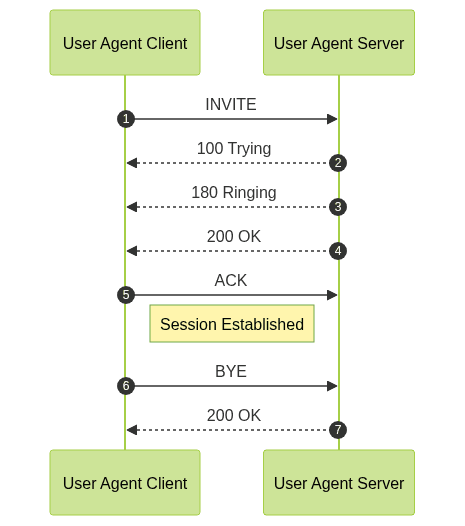What is SIP Request? (2025 Guide)
Session Initiation Protocol (SIP) is a foundational technology in modern real-time communications, powering everything from VoIP calls to video conferences. But what is a SIP request? In the context of SIP protocol, a SIP request is a structured message used to initiate, modify, or terminate multimedia sessions—such as voice or video calls—over IP networks. SIP requests are the lifeblood of SIP signaling, enabling endpoints and servers to communicate session intentions and negotiate parameters.
Understanding SIP requests is essential for developers and engineers working with VoIP, UC (Unified Communications), or any SIP-based architecture. They define how calls are set up, managed, and torn down, ensuring interoperability and reliability in diverse network environments. Mastering SIP request construction, interpretation, and troubleshooting is key to implementing robust, scalable communication solutions in 2025 and beyond.
SIP Protocol Overview
The SIP protocol, standardized in RFC3261, is a text-based signaling protocol designed to establish, modify, and terminate multimedia sessions over IP. SIP forms the backbone of VoIP SIP services, IP telephony, instant messaging, and presence systems worldwide. For developers building modern communication apps, integrating a
Video Calling API
can streamline the process of adding real-time video and audio features powered by SIP.At its core, SIP operates through a series of request and response messages exchanged between clients (User Agents) and servers (Proxy, Registrar, Redirect). SIP requests drive session initiation, participant discovery, and negotiation of session details. SIP architecture is designed to be scalable, flexible, and protocol-agnostic, making it suitable for a broad range of communication applications.
A typical SIP session involves multiple SIP request/response exchanges—such as INVITE (to initiate a call), ACK (to confirm session setup), and BYE (to terminate a call)—forming the backbone of SIP call flow. Developers must understand the essential SIP message format and transaction model to build effective SIP implementations. Leveraging a
Voice SDK
can further enhance audio call experiences in SIP-based applications.Anatomy of a SIP Request Message
A SIP request message follows a strict structure defined by the SIP protocol. Understanding the anatomy of a SIP request is crucial for both SIP implementation and troubleshooting. If you're looking to build or test SIP-powered mobile apps, following a
callkit tutorial
can help you integrate native calling interfaces on iOS devices.SIP Request-Line
Every SIP request starts with a Request-Line, which specifies the SIP method (such as INVITE), the SIP URI of the destination, and the SIP protocol version. The SIP Request-Line is fundamental, as it directs the intent and target of the request.
Example SIP Request-Line:
1INVITE sip:alice@example.com SIP/2.0
2Here,
INVITE is the SIP method, sip:alice@example.com is the SIP URI, and SIP/2.0 specifies the protocol version.Common SIP Methods
- INVITE: Initiate a call or session
- ACK: Confirm session establishment
- BYE: Terminate a session
- REGISTER: Register a user agent with a SIP registrar
- OPTIONS: Query server capabilities
- CANCEL: Cancel a pending request
Structure of a SIP Request Message
A SIP request message consists of:
- Request-Line (method, URI, version)
- SIP Headers (key-value pairs, similar to HTTP headers)
- Blank line (CRLF)
- Message body (optional, e.g., SDP for media negotiation)
SIP Request Example:
1INVITE sip:bob@voipprovider.com SIP/2.0
2Via: SIP/2.0/UDP 192.0.2.101:5060;branch=z9hG4bK776asdhds
3Max-Forwards: 70
4To: Bob <sip:bob@voipprovider.com>
5From: Alice <sip:alice@example.com>;tag=1928301774
6Call-ID: a84b4c76e66710@192.0.2.101
7CSeq: 314159 INVITE
8Contact: <sip:alice@192.0.2.101>
9Content-Type: application/sdp
10Content-Length: 142
11
12v=0
13o=alice 2890844526 2890844526 IN IP4 192.0.2.101
14s=-
15c=IN IP4 192.0.2.101
16t=0 0
17m=audio 49170 RTP/AVP 0
18This example demonstrates the SIP message format, showing the key headers and a sample SDP body for media negotiation. For developers seeking to add calling features to their apps, exploring a
phone call api
can provide valuable insights into available solutions.Main SIP Headers Explained
SIP headers carry essential signaling information. Here are the most common headers found in SIP requests:
| Header | Purpose |
|---|---|
| Via | Tracks the SIP path and prevents loops |
| Max-Forwards | Limits the number of hops to prevent infinite loops |
| To | Specifies the recipient of the request |
| From | Identifies the initiator of the request |
| Call-ID | Uniquely identifies the SIP session |
| CSeq | Sequence number for transactions, pairs with SIP method |
| Contact | Contact address for subsequent requests |
| Content-Type | Indicates the type of the message body (e.g., application/sdp) |
Header Details:
- Via: Used for routing responses and identifying network hops. Each proxy appends its own Via header.
- Max-Forwards: Decrements at each hop; when zero, the request is not forwarded further.
- To/From: Define the logical endpoints (users) involved in the session. The From header often contains a unique tag to distinguish dialogs.
- Call-ID: Critical for matching requests and responses belonging to the same session.
- CSeq: Combines a sequence number and method to uniquely identify transactions.
- Contact: Specifies where the sender can be reached for future requests.
- Content-Type: Tells the recipient how to parse the message body, such as SDP for media parameters.
Understanding these headers is vital for correct SIP request handling and SIP troubleshooting. If you want to quickly add real-time communication features, you can
embed video calling sdk
components directly into your web or mobile applications.Types of SIP Requests
SIP defines several request types (methods), each serving a specific purpose in SIP signaling and call flow:
- INVITE: Begins a new session (call setup)
- ACK: Confirms session establishment after INVITE
- BYE: Terminates an active session
- REGISTER: Registers a user agent with a SIP registrar
- OPTIONS: Queries a server's capabilities
- CANCEL: Cancels a pending request (typically an INVITE)
For developers working with web technologies, a
javascript video and audio calling sdk
can simplify SIP-based communication implementation in browser-based applications.
This SIP call flow depicts the typical SIP request/response interactions during call setup using INVITE, with provisional and final responses.
SIP Request Lifecycle: How It Works
The SIP request lifecycle revolves around SIP transactions and dialogs. Here's how a typical SIP call setup works:
- Client (User Agent Client) sends an INVITE to initiate a session
- Server (User Agent Server) processes the request and responds with provisional (100 Trying, 180 Ringing) and final (200 OK) responses
- Client acknowledges final response with ACK
- Session is established; media can flow directly or via a relay
- BYE is sent to terminate the session
SIP transactions group related request/response messages (e.g., INVITE and its responses). Dialogs represent persistent peer-to-peer relationships formed by INVITE, ACK, and response messages.
If you're developing cross-platform apps, exploring
flutter webrtc
can help you implement SIP-based video and audio calling in Flutter projects.
This diagram visualizes the SIP request/response cycle for a basic call, highlighting key SIP transaction points.
SIP Request vs HTTP Request
SIP and HTTP are both text-based, request/response protocols, but they serve different purposes:
- SIP is designed for real-time session control (calls, conferences, messaging), supporting stateful transactions and dialogs.
- HTTP is stateless and optimized for document retrieval (web browsing).
Both protocols use similar message syntax (headers, methods), but SIP's features—such as transaction handling, dialog management, and session negotiation—make it uniquely suited for VoIP and UC applications. Developers familiar with HTTP will find SIP's structure recognizable but should be aware of its stateful nature and focus on real-time signaling. For native Android development,
webrtc android
resources can help you implement SIP-powered audio and video calls efficiently.Common Use Cases for SIP Requests
SIP requests lie at the heart of modern communications, enabling:
- VoIP calls (audio/video calls over IP)
- Video conferencing
- Instant messaging and presence
- Unified Communications (UC) platforms
From softphones to cloud PBXs, SIP requests underpin the signaling for session management in diverse real-time applications. For more advanced iOS integration, following a
callkit tutorial
can help you create seamless calling experiences that leverage SIP signaling.Best Practices for SIP Request Implementation
- Ensure proper formatting: Adhere to SIP RFC3261 message structure to ensure interoperability
- Security: Use TLS for SIP signaling when possible, and implement authentication and authorization for endpoints
- Troubleshooting: Employ detailed logging and SIP tracing tools to diagnose issues with SIP message format or call flow
- Testing: Use SIP test tools (sipp, Wireshark) to validate implementation
By following these best practices, developers can create robust, secure, and interoperable SIP-based solutions.
SIP Request Troubleshooting and Debugging
Troubleshooting SIP requests involves understanding common errors and having the right tools:
- Malformed headers: Can cause parsing failures or call setup errors
- Authentication errors: 401 Unauthorized or 407 Proxy Authentication Required responses often indicate misconfigured credentials
- Unsupported methods or headers: May cause 501 Not Implemented or 420 Bad Extension errors
Tools:
- Wireshark: Analyze SIP call flow and message format in detail
- sngrep: Visualize SIP dialogs and transactions in real time
- SIPp: Simulate SIP call scenarios for testing and load generation
Effective SIP troubleshooting accelerates development and ensures smooth deployment.
Conclusion: Why Understanding SIP Requests Matters
For VoIP and UC engineers, mastering SIP requests is essential for building, scaling, and maintaining modern communications systems. A deep understanding of SIP message format, headers, and call flows empowers developers to create interoperable, secure, and resilient real-time applications—making SIP expertise a must-have skill in 2025 and beyond.
Want to level-up your learning? Subscribe now
Subscribe to our newsletter for more tech based insights
FAQ